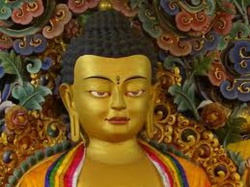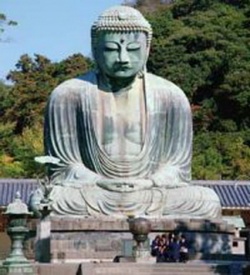Difference between revisions of "Arousing Bodhichitta"
(Created page with "thumb|250px| <poem> by Yukhok Chatralwa Chöying Rangdrol Bodhichitta is that which makes the path of Mahayana special, and you should know its benefits, as...") |
|||
| Line 36: | Line 36: | ||
[[Category:Buddhist Terms]] | [[Category:Buddhist Terms]] | ||
[[Category:Ngöndro]] | [[Category:Ngöndro]] | ||
| − | [[Category: | + | [[Category:Bodhicitta]] |
Revision as of 15:24, 14 March 2013
by Yukhok Chatralwa Chöying Rangdrol
Bodhichitta is that which makes the path of Mahayana special, and you should know its benefits, as well as how to take the vow, and the precepts and so on, all in precise detail.
Consider that you and all other beings are seated before the field of merit, visualized just as in the refuge practice, and, with a firm resolve to take the vow of bodhichitta, recite the words of the text:
Ho! Mesmerized by the sheer variety of perceptions, which are like the illusory reflections of the moon in water,
Beings wander endlessly astray in samsara’s vicious cycle,
In order that they may find comfort and ease in the luminosity and all-pervading space of the true nature of their minds,
I generate the immeasurable love, compassion, joy, and equanimity of the awakened mind, the heart of bodhichitta.
Repeat these lines three times or as many times as possible. The initial syllable ‘Ho’ is an expression of wonder or amazement. What is so wonderful and amazing? Generating bodhichitta out of a state complete with the four immeasurable qualities, so that all sentient beings may find comfort and ease in the luminosity and all-pervading space of the true nature of their minds. That is amazing. Others say that this is an expression of compassion, in which case the objects of our compassion are all suffering beings. Then there are those who say it is an expression of sadness.
Sentient beings experience all kinds of happiness and suffering as a result of the various actions they have committed in the past. These mistaken experiences in their own minds are just like the reflections of the moon in water: they appear, but when examined, they are not real. Neither subject nor object is to be found at the time of the fundamental ground or at the time of the ultimate result. So these temporary delusory appearances, which are false and deceptive, are just like a variety of paintings created by the diversity of our own past actions. As it is said, “Karma is like an artist.” Even a single body of water will be perceived differently by the beings of the six classes, as a result of their particular karma and habitual tendencies, and as long as they have this dualistic deluded mind, beings will continue to wander endlessly astray in samsara’s vicious cycle.
Now we are practising so that they might be freed from their karmic vision and habitual patterns, and arrive at the luminosity and all-pervading space of the true nature of their minds, reaching the level of buddhahood, where they will find comfort, ease and relief from all the exhaustions and hardships brought about by their own non-virtues. To this end, we generate immeasurable compassion, which is the wish that they may be freed from suffering and its causes, together with its cause, immeasurable equanimity, which is the wish that they may be freed from attachment to close friends and family and aversion to enemies. Likewise, we generate immeasurable love, which is the wish that they may have happiness and its causes, and immeasurable joy, which is the wish that they may never be separated from happiness and its causes. With the force of the compassion born of the first two immeasurables, we focus on all sentient beings throughout the whole of space. Then with the latter two qualities, we focus on complete enlightenment with the strength of wisdom—wishing, with immeasurable love, that they gain the very highest form of happiness by attaining the dharmakaya luminosity, and wishing, with immeasurable joy, that they never part from it.
Having trained our minds in these four immeasurable qualities again and again, we generate the bodhichitta of aspiration, by saying to ourselves: “In order to bring all sentient beings to the lasting happiness of complete liberation, I will do whatever I can to attain the precious level of perfect buddhahood.” And we generate the bodhichitta of application, thinking: “To that end, I will train in the vast activity of the bodhisattvas, represented by this profound path, and strive with diligence until not a single being is left behind in samsara.”
To make the practice more elaborate, at this point we could practise considering others as equal to ourselves and exchanging ourselves and others. In particular, it is crucially important that we focus on giving away our own happiness as we breathe out and taking on the sufferings of others as we breathe in—the practice of ‘giving and receiving’ or tonglen—and that we meditate as much as we possibly can on absolute bodhichitta, the union of tranquillity (shamatha) and insight (vipashyana), in which there is certainty regarding the selflessness of individuals and of phenomena.
In the biography of the precious lord Atisha it is told how, having arrived in Tibet, he said to Geshe Tönpa and others:
If you lack bodhichitta, then whatever you do, whether listening to many teachings, studying, reflecting, meditating, practising the generation and completion phases, meditating on the view of Madhyamaka, or reciting mantras and such, it will be of no use. All virtuous actions that are not combined with bodhichitta and all virtuous actions that weaken our bodhichitta are the agency of Mara.
At the end of the session, consider that you and all sentient beings dissolve into the objects of refuge. They dissolve into the lama in the centre. He, in turn, dissolves into the primordial expanse of the dharmakaya, free from any conceptual elaboration, and you rest in meditation. Alternatively, you could consider that, at the end of the session, the field of merit melts into light, beginning at its outer edges, and then dissolves into the lama in the centre. He too melts into light, and dissolves into you at the crown of your head. Through this, the absolute bodhichitta present within their minds arises vividly in your own mind, and you dedicate the merit.
As the precepts of the bodhichitta of aspiration, train in consider others as equal to yourself, exchanging yourself and others, and considering others as more important than yourself. As the precepts of the bodhichitta of application, train in the six transcendent perfections.
| Translated by Adam Pearcey, Rigpa Translations, 2006 (revised 2012). Thanks to Ringu Tulku Rinpoche for his clarifications.

